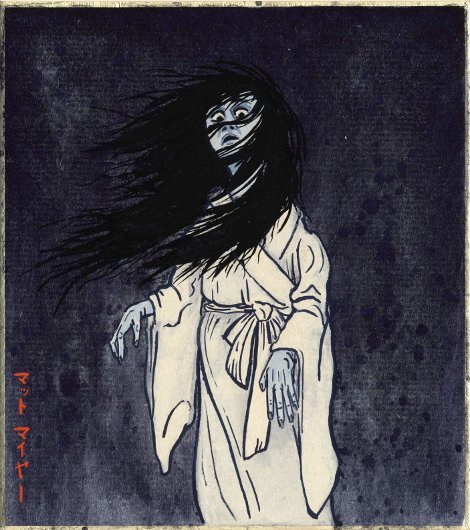In the late 17th century, a game called Hyakumonogatari Kaidankai became popular, and kaidan increasingly became a subject for theater, literature and other arts. At this time, they began to gain certain attributes to distinguish themselves from living humans, making it easier to spot yurei characters.
Ukiyo-e artist Maruyama Okyo created the first known example of the now-traditional yurei, in his painting The Ghost of Oyuki.
Today, the appearance of yurei is somewhat uniform, instantly signalling the ghostly nature of the figure, and assuring that it is culturally authentic.
- White clothing – Yurei are usually dressed in white, signifying the white burial kimono used in Edo period funeral rituals. In Shinto, white is a color of ritual purity, traditionally reserved for priests and the dead. This kimono can either be a katabira (a plain, white, unlined kimono) or a kyokatabira (a white katabira inscribed with Buddhist sutras). They sometimes have a hitaikakushi (lit., “forehead cover”),[dubious – discuss] which is a small white triangular piece of cloth tied around the head.
- Black hair – Hair for a yurei is often long, black and disheveled, which some believe to be a trademark carried over from Kabuki Theater, where wigs are used for all actors. However, this is a misconception. Japanese women traditionally grew their hair long and wore it pinned up, and it was let down for the funeral and burial.
- Hands and feet – A yurei’s hands dangle lifelessly from the wrists, which are held outstretched with the elbows near the body. They typically lack legs and feet, floating in the air. These features originated in Edo period ukiyo-e prints, but were quickly copied over to kabuki. In kabuki, this lack of legs and feet is often represented by the use of a very long kimono, or even hoisting the actor into the air by a series of ropes and pulleys.
- Hitodama – Yurei are frequently depicted as being accompanied by a pair of floating flames or will o’ the wisps (Hitodama in Japanese) in eerie colors such as blue, green, or purple. These ghostly flames are separate parts of the ghost rather than independent spirits.

